Metéora, Greece – 2/2014
During the last few months in Europe we had seen more than our share of churches and monasteries, but as we drove through the valley north of Kalambáka we saw the first of the amazing monasteries of Metéora, balanced on what seemed to be totally impossible rocky pinnacles and cones, surrounded by sheer cliffs. The mind first asks “how”, followed by “why”. We parked and stood looking up at one of the greatest sights of mainland Greece. Metéora literally means “middle of the sky”, “suspended in the air” or “in the heavens above”.
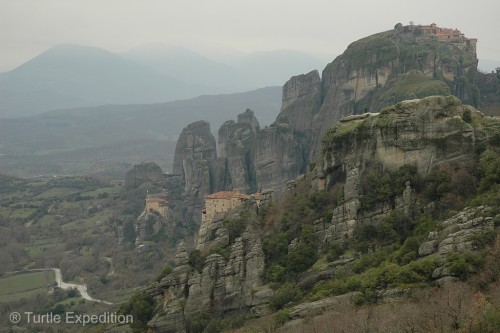 Caves in the vicinity of Metéora were inhabited continuously between 65,000 and 5,000 years ago. The oldest known example of a man-made structure, a stone wall that blocked two-thirds of the entrance to the Theopetra Cave, was constructed 23,000 years ago, probably as a barrier against cold winds – the Earth was experiencing an ice age at the time. Many Paleolithic and Neolithic artifacts have been found in some of the caves.
Caves in the vicinity of Metéora were inhabited continuously between 65,000 and 5,000 years ago. The oldest known example of a man-made structure, a stone wall that blocked two-thirds of the entrance to the Theopetra Cave, was constructed 23,000 years ago, probably as a barrier against cold winds – the Earth was experiencing an ice age at the time. Many Paleolithic and Neolithic artifacts have been found in some of the caves.
In the 9th century AD, an ascetic group of hermit monks moved up to the ancient pinnacles. They were the first people to inhabit Metéora since the Neolithic Era. They lived in hollows and fissures in the rock towers, some as high as 1800 feet, (550m), above the plain. This great height, combined with the sheerness of the cliff walls, kept away all but the most determined visitors.
The only means of reaching some of them was by climbing a series of long ladders lashed together or large nets used to haul up both goods and people. “The net in which intrepid pilgrims were hoisted up vertically alongside the 1,224 ft, (373-meter), cliff required quite a leap of faith. The ropes were replaced, so the story goes, only “when the Lord let them break”.
Seeking a retreat from the expanding Turkish occupation, the monks found the inaccessible rock pillars of Metéora to be an ideal refuge. More than 20 monasteries were built, beginning in the 14th century. Six remain today.
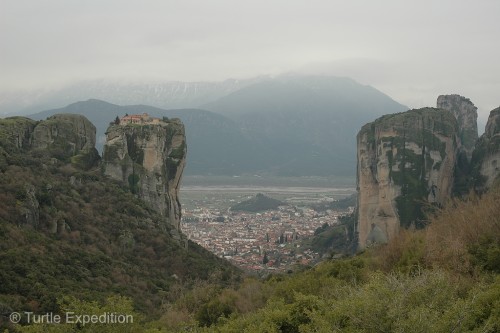 In 1517, the monastery of Varlaám was built. It was reported to house the finger of St John and the shoulder blade of St Andrew. Today Varlaám dominates the valley and symbolizes the fragility of a traditional way of life that is threatened with extinction.
In 1517, the monastery of Varlaám was built. It was reported to house the finger of St John and the shoulder blade of St Andrew. Today Varlaám dominates the valley and symbolizes the fragility of a traditional way of life that is threatened with extinction.
Of the six monasteries that remain today four are inhabited by men, and two by women. Each monastery has fewer than 10 inhabitants. The monasteries are now tourist attractions which may taint their historic presence but fund the preservation of this unique way of life and religion.
An interesting plaque inside the Holy Monastery of Great Metéoron offered some answer to the “why”.
The monastic vocation is a lifetime’s unswerving dedication to Christ the Groom. The only purpose, the only passion of the monk is to follow Christ with one’s eyes turned to the heavens. The monk walks the hard, narrow path of penitence. He exchanges his own will for absolute obedience; he gives up wealth to poverty, comfort for denial, fame and glory for humiliation. The main task of the monk is to pray. His ardent heart, transmuted by prayer, opens up to and embraces the whole of creation, the whole of mankind, all the suffering souls, all the souls in temptation, whom he never ceases to love, to comfort and to succor.
- As we drove through the valley north of Kalambáka we saw the first of the amazing monasteries of Metéora, balanced on what seemed to be totally impossible rocky pinnacles and cones, surrounded by sheer cliffs.
- The great height, combined with the sheerness of the cliff walls, kept away all but the most determined visitors.
- The only means of reaching some of them was by climbing a series of long ladders lashed together or large nets used to haul up both goods and people.
- Seeking a retreat from the expanding Turkish occupation, the monks found the inaccessible rock pillars of Metéora to be an ideal refuge.
- Tourism has become an important way to preserve this traditional way of life that was threatened with extinction. Thankfully, the rope and net basket are no longer used for transportation of visitors to the Holy Monastery of Great Metéoron.
- The old man-powered rope windless (no winch) and net are still in place. The ropes were replaced, so the story goes, only “when the Lord let them break”.
- The rope and net method, as you were hauled up a 1,224 ft, (373-meter), precipice might have been an ideal place to pray!
- To facilitate visitors, narrow walkways were literally carved and chipped out of the solid rock cliffs.
- It is hard to imagine how the materials were transported up the sheer cliffs to build these beautiful monasteries.
- The Monastery of Transfiguration of the Savior or Great Metéoron, the oldest and the largest monastery of Metéora, had a wonderful collecting of beautiful icons and the historical documents.
- Far from the sins and evils of civilization below, the monasteries offered a sense of the serenity they provided and protected.
- Displays at the Holy Monastery of Great Metéoron had some wonderful rooms like this one of a kitchen which gave us a sense of what life was like.
- In the History and Folklore Museum beneath the old refectory, displays of wine and olive presses gave us an interesting impression of just how totally self-sufficient the life of a monk was.
- Simple meals were probably one of the few times the monks gathered together.
- The old refectory at the Holy Monastery of Great Metéoron houses the Georgios Taloulakis Gallery of Religious Art, with paintings by Kalabaka, Kostas Adamos and others.
- One of the perks of being a founder of a monastery is that your skull will be on display forever.
- We met these two visiting Russian priests or monks in the parking lot. As you might expect, they were regular guys, fascinated by our truck.



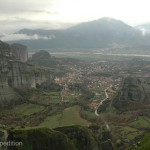
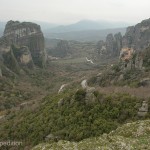
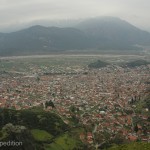
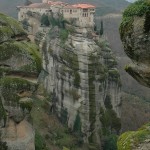
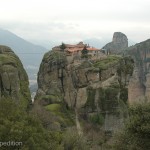
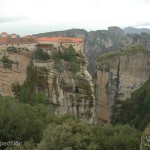
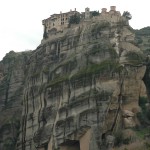
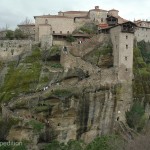
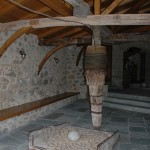
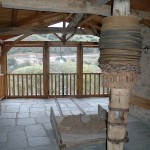
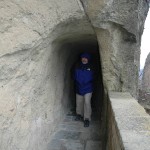
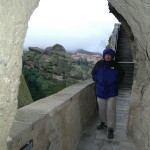
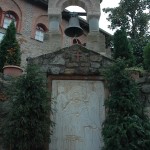
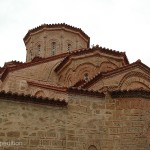
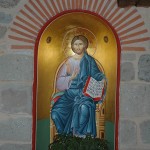
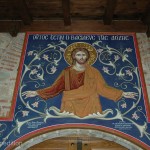
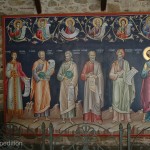
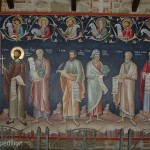
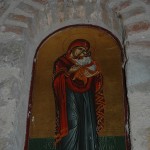
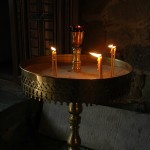
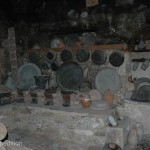
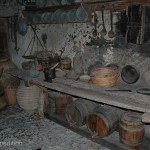
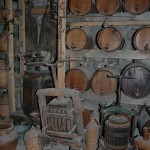
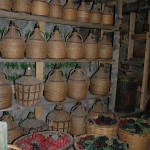
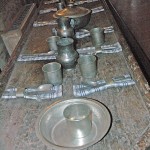
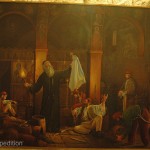
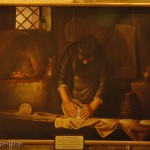
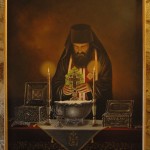
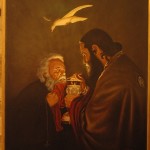
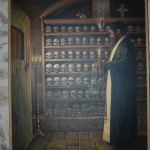
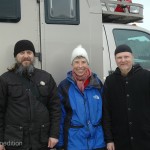





Michelle Lyons liked this on Facebook.
Paul Graham liked this on Facebook.
Michelle Curtis liked this on Facebook.
David Ross liked this on Facebook.
Devin Estevez liked this on Facebook.
Arie Zali liked this on Facebook.
Martine Cos liked this on Facebook.
That’s amazing!
Thomas Woodson liked this on Facebook.
Carl von Bargen liked this on Facebook.
Ildo Costa Nunes liked this on Facebook.
Jeffery R Socha liked this on Facebook.
José Conde liked this on Facebook.
Dave Sunderland liked this on Facebook.
김경수 liked this on Facebook.
Gonçalo Constantino liked this on Facebook.
Isabelle Szezarvirski liked this on Facebook.
Dottie Wolcott Nobles liked this on Facebook.
Soares Periquito liked this on Facebook.
Mike Pasqualini liked this on Facebook.
GeneralDouglaa Fraser liked this on Facebook.